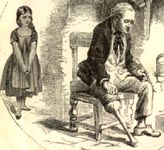Realism in Art and Literature in the 19th Century
This iCue Mini-Documentary describes the emergence of a new, gritty realism in 19th-century writing and painting.
This feature is no longer available.
This iCue Mini-Documentary describes the emergence of a new, gritty realism in 19th-century writing and painting.
This feature is no longer available.
This workshop addresses the questions "In what ways is Jacob Riis's How the Other Half Lives a document of progressive reform?," "What does How the Other Half Lives tell us about urbanization and immigration?," and "How does Riis use photography in How the Other Half Lives?"
The Center's online resource workshops give high school teachers of U.S. history and American literature a deeper understanding of their subject matter. They introduce teachers to fresh texts and critical perspectives and help teachers integrate them into their lessons. Led by distinguished scholars and running 60 to 90 minutes, they are conducted through lecture and discussion using conferencing software. A resource workshop identifies central themes within a topic and explores ways to teach them through the close analysis of primary texts, including works of art, and the use of discussion questions. Texts are drawn from anthologies in the Center's Toolbox Library. To participate, all that is needed is a computer with an internet connection, a speaker, and a microphone.
"The Highwaymen were a group of self-taught African American artists from Fort Pierce who painted their way out of poverty in the 1950s. While they have burst into Floridians' consciousness in recent years, Harold Newton-leader of the Highwaymen and major Florida landscape painter-will help bring them to national acclaim. Photographer/author Gary Monroe tells the story of Newton and the Highwaymen by providing an overview of quintessential paintings, featuring some of Newton's finest creations."

These full-text transcriptions and page images of 163 "Sunday school books" address religious instruction for youth published in the U.S. between 1815 and 1865. Materials include texts used by Methodists, Baptists, Mormons, and other denominations and are searchable by subject, author, title, and keyword.
Books are categorized according to nine types: "Advice Books, Moral Tales"; "Animals, Natural History"; "Child Labor, Orphans, Poverty"; "Death, Dying, Illness"; "Holidays"; "Immigrants"; "Slavery, African Americans, Native Americans"; "Temperance, Tobacco"; and "Travel, Missionaries." There are 67 author biographies and an essay on Sunday school books. This collection offers valuable materials for studying antebellum culture, American religious history, print culture, and education.